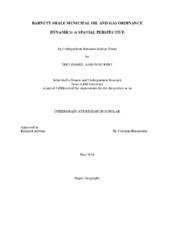| dc.description.abstract | Previously unattainable shale gas deposits have become accessible since the late 1990s using a technique called hydraulic fracturing — the injection of chemicals, water, and sand into subsurface shale to free extractable gas. This practice, along with the recent optimization of horizontal drilling, has substantially increased United States oil and gas production. Hydrocarbon firms perfected and use hydraulic fracturing on the Barnett Shale in North Texas; due to the nature of the formation, gas companies have installed wells in urbanized areas. Hydraulic fracturing generates employment and royalties for many Texas communities and mineral estate holders, but perceived health, safety, and environmental risks have prompted municipal policymakers to enact ordinances that regulate shale gas pad sites in urban areas. This thesis analyzes several facets of this series of policies: 1) the setback distance between residences and gas well pad sites and 2) the similarities in municipal ordinance texts. These objectives were carried out through the qualitative coding and analysis of 79 Barnett Shale municipal ordinances; these codes were then investigated using a GIS software package and Excel to search for spatial trends. Additionally, from October 2013 to February 2014, the investigator traveled to several North Texas municipalities and interviewed key-actors who have proposed and enacted such ordinances. Finally, a case study of the Dallas intra-municipality debate regarding the wording and context of their oil and gas ordinance has been used to show how municipalities conceptualize their own regulations. While limited spatial correlations were found, this thesis determined that policymakers selectively create and copy ordinance text that best conforms to a preexisting bureaucratic and political culture. | en |


